HYDROPOWER: Finding a balance between man's need for energy and nature's stability.
The name hydropower is the gotten from the combination of two words; hydro and power. "Hydro" on its own means "from water". Therefore, we define hydropower as an energy which is derived from the force of a moving water.
While Hydroelectricity is the electricity produced from the energy of moving water.
Water cycle is one of nature's act to keep everything in balance. When the sun shines, it evaporates water moisture on the earth's surface, oceans, seas, rivers e.t.c. This evaporated moisture moves up to the atmosphere were it condenses to form cloud, and when the cloud gets saturated, it falls back to earth as a precipitation, replenishing what was lost.
Force of gravity always makes sure that things up comes down, fortunately, water is not exempted. Now, when gravity drives this water at a higher ground to avoid lower ground, it causes the moving to move with a great acceleration, thus, the force of the moving water can be able to move anything on it's path.
Since both the water cycle and the gravity keeps making sure that we have plenty of fast moving water, we classify this hydropower as a renewable energy source.
Hydropower is called a renewable energy source because it is replenished by snow and rainfall. As long as the rain falls, we won't run out of this energy source. This means that once earth keeps experiencing rainfall and other precipitation, we will never lack hydropower.
Right now, let's get to know how man got to realize this power and how he began to harness it.
A BRIEF HISTORY OF HYDROPOWER
Hydropower is one of the earliest energies harnessed by man. In their own way, those that lived about 2000 years ago made use of hydropower, though not to generate electricity, but for powering simple machines like, the water wheel which was used for grinding of wheat into flour. The greeks are among the notable people that harnessed this energy.
It wasn't until the early 1800's did man discover a way of using this water wheel for a better purpose than just the grinding of wheat. It was the American and European factories that were the first to use this wheel to power their machines.
The idea of the water wheel is very simple, what the water wheel does is to pick up flowing water with the use of the paddle shaped a bit like buckets which are placed round its wheel. Due to the weight of the water in those "buckets", the wheel turns, and thus converting the kinetic energy of the water to mechanical energy. Now, this mechanical energy that is generated can be used for pumping of water, grinding of grains, driving of sawmills e.t.c
Close to the end of 19th century, man discovered how to harness the potential energy of falling water. The first hydroelectric power plant in the world was built at the Niagara Falls in the year 1879. By 1880, a dynamo powered by electricity from a water turbine was used to generate an arc lighting in a theatre in Grand Rapids Michigan. In 1881, street lighting at Interlaken was powered by a dynamo connected to the turbine used in a flour mill, you can add visiting the spot as part of your list of things to do in Interlaken. Since then, till today, hydroelectric power have been the talk of the day.
Mind you that the electricity generated by these turbines are alternating current unlike the direct current which were been used at that time. And this alternating current has an advantage over the direct current, as it can been transmitted over a long distance.
TYPES OF HYDROELECTRIC POWER PLANTS
We have two major types of hydroelectric power plants: One is the common hydroelectric power plant, the other is the pumped storage plant.
The Common hydroelectric power plant:-
This type of hydropower plant is very common compared to the other. This type makes use of the dam on a river to fill up its reservoir. Later, this water in the reservoir is released and it is directed to the turbine, which turns as the water makes impact with its blade. This turbine in turn activates the generator resulting to the production of electricity.
The pumped storage plant:-
In addition to generating electricity just like the common type, this type has the capability to store power. Whenever there is excess of current, power is been sent back into the generators from the power grid. Due to this power sent into the generators, the generators causes the turbines to spin backwards, and as a result, water is been pumped from the river to the upper reservoir, thus storing the excess electric energy in the form of potential energy of the water. When the energy is needed, the water is been released to the turbine and which now turns in the forward direction to produce electricity.
THE MAJOR COMPONENTS OF A HYDROELECTRIC PLANT
There are basically six major components found in all hydroelectric plants, regardless of its size, shape and model. These components are dam, water reservoirs, water turbine, generator and intake or control gates.
Dam:-
The dam is the basic part of a hydropower plant. It is always build on a river that has so much water flowing through it always. Dams are normally placed in a position that enables it obtain the maximum potential energy from the falling water.
Note:-
You don't necessarily need a dam to generate hydroelectric power. You can place the hydroelectric power plant in a small canal, such that the river water is channeled directly into the turbine.
Reservoir
Another important component of a hydropower plant, the reservoir is where water is stored. It is found behind the dam. The water in the reservoir is at a position higher than the dam structure. The higher the water, the higher the potential energy possessed by the water. Another reason for the height is so as to enable the easy flow of the water down to the turbine.
Note:- The water in the reservoir is at a higher position than the water flowing in the river.
Control or Intake Gates:-
These gates are built inside the dam, and their job is to control the release of the water from the reservoir. The reason why these gates are also referred to as inlet gates is because, through them, water enters the power generation unit. What happens is that, whenever these gates are open, the water in the reservoir flows down to the turbine through penstock due to the action of gravity on it. Thus, it is the control gates that determine the amount of water passing through the penstock. It is worth noting that as this water flows past this gate, it possess both potential and kinetic energy.
Penstock
The penstock is like a very long pipe. It's job is to transport water from the reservoir to the power generation unit. The power generation unit is made up of the turbine and the generator. As we said earlier, this water that flows down this pipe possesses both potential energy (due to its height) and kinetic energy (which is as a result of its motion). The amount of electricity generated by the hydopower plant is determined by the height of the water and also the amount of water flowing through the penstock.
Water Turbines:-
This is where the potential and kinetic energy of the water is put to work. When the water that flows through the penstock gets to the power generation unit which consist of the generator and the turbine, it falls on the blades of the turbine. Due to the P.E and K.E possessed by the water, the blades of the turbine are turned. There is a shaft connected to the blades of the turbine blades, thus, when the blades rotate, this shaft rotates too.
We have so many types of turbines, like the Kaplan turbine, the Francis turbine, Pelton turbine e.t.c. The turbine to be used on a hydroelectric power plant will depend on the height of the reservoir, the amount of power hoped to be achieved and the quantity of water the reservoir can carry.
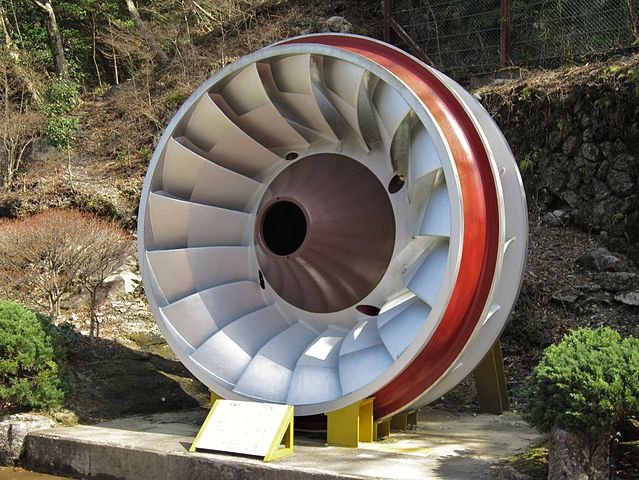
Picture by Qurren WikiCommons CC BY-SA 3.0
A Francis turbine
The difference in height between the water reservoir and the turbine is what we refer to as head of water. This head of water also determines the amount of energy that can be generated by a hydroelectric power plant.
Generator:-
This is the most important part of the hydroelectric power plant because It is where the electricity is produced. The shaft that is connected to the turbine blades rotates inside the generator. When this shaft rotates due to the action of water on the turbine blades, an alternating current is produced in the coil of the generator. What really happens is that, the rotation of the shafts generates a magnetic field inside the generator. Then this magnetic field generated is converted into electricity by electromagnetic field induction.
HOW DOES A HYDROELECTRIC POWER PLANT WORK
The main idea of hydroelectricity is based on how to convert the potential energy of water into electrical energy, this was displayed by Steve Lund in one of his movies. . But for us to achieve that, we need to build the dam in a very big river that has a huge drop in elevation. There is a reservior behind the dam, for storing of water. Close to the bottom of the dam you will find the water control gate and a penstock that is channelled from this gates to the turbine.
When the gates are opened, water flows down through the penstock, due to the difference in pressure and gravity, and deposits itself on the turbine blade, causing them to rotate. The shaft that links the blades to the generators rotates as as a result of the action of the water on the blade, which in turn generates a magnetic field inside the generator.
This means that the potential energy of the water is been converted into mechanical energy in the turbine while the mechanical energy is not converted into electricity by the generator.
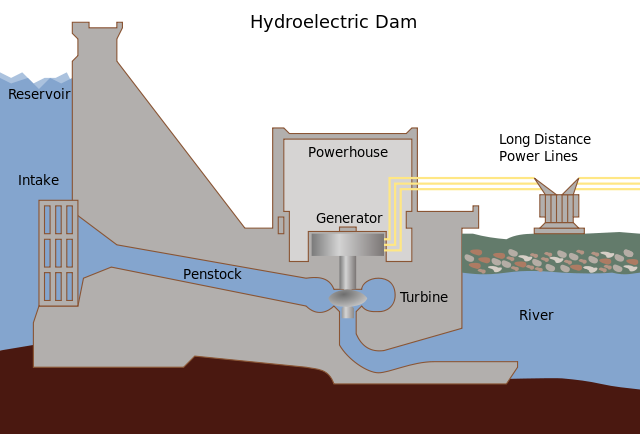
Picture by Tomia - Wikicommons CC BY-SA 3.0
How a hydroelectric power plant works
The generator works based on Faradays two laws of electromagnetic induction which states that :
1st Law:- It states that any change in the magnetic field of a coil of wire will cause an emf to be induced in the coil. Source
2nd Law:- It states that the magnitude of emf induced in the coil is equal to the rate of change of flux that linkages with the coil. Source
The electromagnets in very large generators are made by winding a wire around magnetic steel laminations and then passing a direct current through this loop. Each of these steels are called field poles and they are placed close to the rotor. This rotor is been connected to the turbine shaft and it is made in such a way that it rotates at a fixed speed. Therefore, from time to time, whenever the rotor turns, these electromagnets moves past the conductors that are placed in the stator. This movement causes a voltage to be developed across the generators output terminals and also the flow of electricity.
Power lines are connected to the output terminal of the generator so as to transport this electricity generated to homes, industries and any other place it's needed.
ADVANTAGES OF HYDROELECTRIC POWER
The benefits of hydropower as a source of energy can not be overemphasized. I will be listing out few of these advantages below, and also try to point out the reason why hydropower is a more reliable energy than other forms of energy.
The first advantage is that, hydropower is a green energy. This means that its production and usuage doesn't harm the environment in anyway. Unlike the over-hyped fossil fuels that pollutes the surrounding at its production and usuage stages.
Hydropower is an energy generated from water, and all states in the world have their own water. This means that each of these states can generate their own energy without depending on others for energy.
Water cycle, which is powered by energy from the sun, tries to balance the amount water in a place. This means that if there is no change in climatic conditions of a place, it is expected that an average amount of water should always be available in a place. This makes hydropower a renewable energy as its source is always replenished.
Hydropower plants do have this wonderful ability of generating power from zero to maximum output within seconds and can send power to the grid almost immediately after electricity generation. Also, it has a more reliable backup power in case of disruption in electricity.
Hydropower plants can convert 90% of the potential and kinetic energy of a moving water into hydroelectricity. The highest that can be obtained from a fossil fuel is barely 50%. For this reason, a high percentage of the world's electricity is gotten from hydropower.
Due to the availability of water, the cost of hydroelectricity is very cheap. And it's production comes with zero waste output.
HYDROELECTRIC POWER: A GENERAL SOLUTION FOR MAN'S NEED OF ENERGY
Man have always desired a source of energy that would be a solution to all his need for energy. This energy must be cheap and able to power any machine or device, also be a source of energy, and it must pose little or no effect to the environment. We have seen the advantages of hydropower as a source of energy, considered it's cheapness, it's availability and the fact that it doesn't produce any waste.
Yet we haven't answered this one question, and that is
Is Hydropower man's answer for a universal source for energy?
For us to answer that question, we have to consider if hydropower fulfils these remaining conditions:
It must be able to power every device and machine on earth.
It must be a source of revenue
It should pose little or no harm to the environment.
Powering of Machines:-
Hydropower in the form of hydroelectricity powers everything in our houses. We cook with it, iron our clothes, watch the television, we even charge all our devices with hydroelectricity e.t.c. Come to think of it, what other device/machine do we need in the house or even in our work place that we can't power using photoelectricity. The answer is none.
Few years ago, we were all marveled by the invention of the electric car. We felt a bigger car won't be able to be powered by electricity, today, we even have electric trucks. Surely in the nearest tomorrow, man must have constructed an aeroplane that runs solely on electric charges.
As the world's population is increasing, more cars and planes needs to be manufactured. If we keep powering them with fossil fuels, are we sure that our planet would last the century? But if we decide to manufacture millions of electric cars, we got nothing to worry about.
Having satisfied the first condition, let's move on to the next.
Source of Revenue:-
One of the reasons why the world have not given up totally on fossil fuels is due to the fact that it generates huge profit. It would be unfair to replace fossil fuel with another source of energy that doesn't generate steady profit. This is the point where solar energy failed. The reason is that if a household can be able to buy 1 or 2 solar panels, they won't need to pay anybody for energy supply. Therefore, it is not a source of revenue. Hydropower on the other hand, doesn't just provide a source of revenue for only the owners, it also creates jobs.
Environment:-
Even though generation of hydropower has its own effect on the surrounding, like the construction of dams prevent the flow of fishes upstream, it's effect is not even up to 1/10th of that of fossil fuels, we can live with that. Let's consider these following examples. Hydropower doesn't increase global warming, it doesn't result to ozone depletion, it doesn't cause change in climatic conditions, unlike the fossil fuel whose advantage and effects can be liken to being addicted to drugs. You only feel ecstasy while you are high, but once the effects wears away, you feel more miserable than before.
Having fulfilled all these conditions, we can rightfully say that hydropower is surely the solution for man's need of energy which will also pose little or no threat to the environment.
CONCLUSION
About 71% of the earth's surface is covered with water. Probably, that should have been man's indication from the beginning that hydropower is the energy he needs. Because, if we have taken a clue from nature, probably we won't be in the mess we are in right now. But it is not too late for man, since we have done an assessment and realised that hydropower is a source of energy that if we invest in, it would be a win-win for both man and nature, we should invest all we have in it. Because if we do, not only that we won't have anything hindering us from advancing in technology, also we won't have to worry about the planet destroying anytime soon.
Check out this DIY article: What Happens When You Unplug Throttle Position Sensor? (Explained)
This article is spornsored by steadymechanic.com
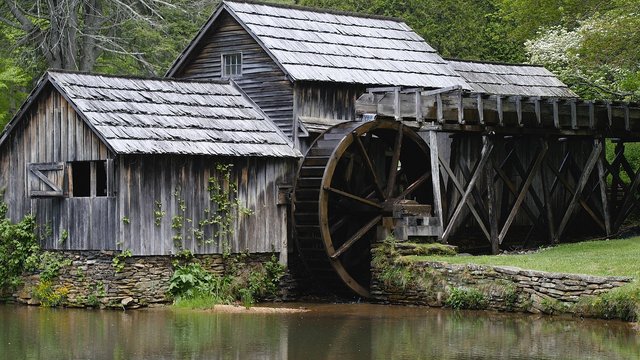
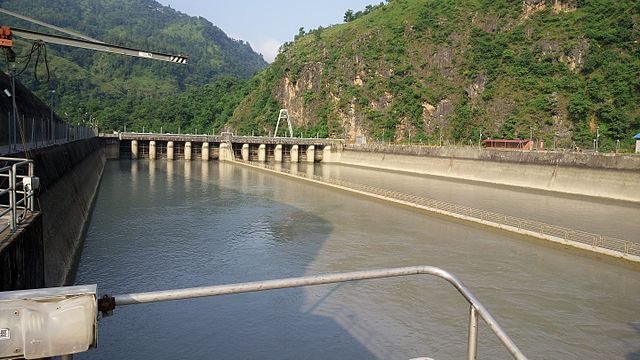
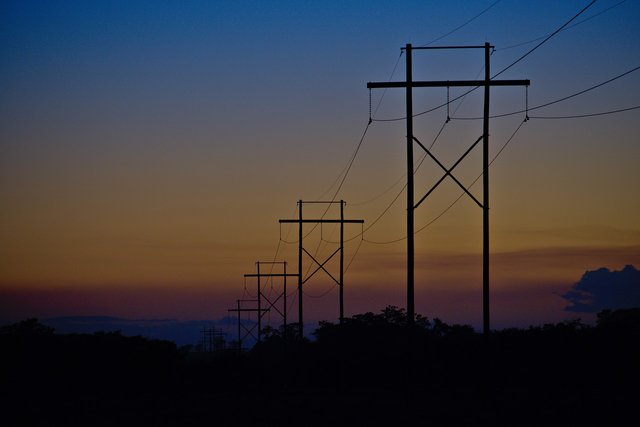
I admit it has it's benefits, but the risks that extensive hydroelectric power brings with it cannot be neglected. Dams have an incredible influence on the ecosystem. Not only flooding huge areas of land but also influencing anything downstream. And out freshwater resources are used up at an alarming rate, making pooling water a risky political move.
@mountainwashere has written a wonderful article here.
I am a big fan of harnessing the tidal powers of the ocean, @pratik27 briefly describes it in a post here.
Both of them did a great work. Their ideas are wonderful. You are right too @sooflauschig, hydropower has its own effect, just like you mentioned, it prevent the upstream flow of fishes, and the failure of dams and reservoirs results to a flood.
But we know that it's harm to our environment is not even compared to 1/10 that of fossil fuel. It is more like the "lesser devil".
Solar and other renewable energies is currently not enough to generate the amount of energy we need. Take for instance, we can only harness 44.5% of solar energy, with the just invented solar panels (@greenrun wore something on that). For now, before we discover a more better way of harnessing other renewable energies, let's just work with hydropower, won't harm our environment as much and as fast as fossil fuels. Hopefully we will discover some other way of harnessing this amazing energy from the sea that won't cause any harm to the environment.
I have to completely agree with you. Avoiding fossil fuel should be the priority.
Surely, thanks for stopping by.